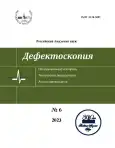Using a magnetic flux leakage method to estimate railway track bolted joint gaps
- Authors: Antipov A.G1, Markov A.A2, Maksimova E.A2
-
Affiliations:
- St. Petersburg State University
- JSC Radioavioniсa
- Issue: No 6 (2023)
- Pages: 11-25
- Section: Articles
- URL: https://journals.rcsi.science/0130-3082/article/view/144353
- DOI: https://doi.org/10.31857/S0130308223060027
- EDN: https://elibrary.ru/ZVSIZQ
- ID: 144353
Cite item
Full Text
Abstract
About the authors
A. G Antipov
St. Petersburg State UniversitySt. Petersburg, Russia
A. A Markov
JSC Radioavioniсa
Email: anarmarkov@gmail.com
St. Petersburg, Russia
E. A Maksimova
JSC RadioavioniсaSt. Petersburg, Russia
References
- Инструкция по текущему содержанию железнодорожного пути: утв. Распоряжением ОАО "РЖД" от 14.11.2016 г. № 2288р.
- Стоянкович Г.М., Пупатенко В.В. Температурные деформации в зоне уравнительных пролетов бесстыкового пути // Путь и путевое хозяйство. 2019. № 6. С. 34-37.
- Черепанов А.Н., Сергеев В.И., Масягутов Р.К., Огарко А.В. Акустический способ обнаружения неисправности рельсового пути / Патент RU 2511644. Опубл. 10.04.2014. Бюл. № 10.
- Snead E. de S. Rail stress detection system and method / Патент US 8934007B2. 2012.
- Архангельский С.В., Розенбаум Л.Б., Козин М.П., Шиханов А.А., Мавроди П.Б., Розенбаум Г.Л. Устройство видеоконтроля состояния поверхности рельсов и рельсовых скреплений / Патент RU 101851. Опубл. 27.01.2011. Бюл. № 3.
- Шилов М.Н, Третьяков А.А., Алексеев Д.В. Средства и технологии автоматизированной системы видеоконтроля объектов железнодорожной инфраструктуры // Путь и путевое хозяйство. 2021. № 9. С. 11-12.
- Goda W., Itoi K., Nagamine N., Tsubokawa Y. Rail Joint Gap Measurement Method using Train Frontal Images Captured by a Handy Video Camcorder // IEEJ Transactions on Industry Applications 2023. V. 143. Iss. 1. P. 46-55.
- Yilmazer M., Karakose M., Aydin I. Detection and Measurement of Railway Expansion Gap with Image Processing / 2021 International Conference on Data Analytics for Business and Industry. 2021. P. 515-519.
- Mizuno T., Mochizuki D., Kawasaki S., Watanabe S., Enoki S., Yamada H. Measurement of singular joint gap of the rails by means of rail joint gap sensor with detecting coil which is crossed to the exciting coil / IEEE International Magnetics Conference. 2002. P. FV2.
- Архангельский С.В., Козин М.П., Розенбаум Л.Б., Шиханов А.А. Устройство для величины стыковых зазоров и вертикальных ступенек железнодорожного пути / Патент RU 55716. Опубл. 27.08.2006. Бюл. № 24.
- Запускалов В.Г., Егиазарян А.В., Редькин В.И., Рябцев В.К., Туробов Б.В. Устройство для многопараметрового контроля объектов путей сообщения / Патент RU 2082640. Заявка: 96 96108055. 05.05.1996.
- Туборов Б.В., Дрындрожик Д.Э., Дегтярев О.Ю. Устройство для измерения тепловых зазоров в стыках рельсов железнодорожного пути / Патент RU 2192982. Опубл. 20.11.2002. Бюл. № 32.
- Инструкция по оценке состояния рельсовой колеи путеизмерительными средствами и мерам по обеспечению безопасности движения поездов: утв. Распоряжением ОАО "РЖД" от 28.02.2020 № 436р.
- Machado M., Ricci E.L.B. System and method for detecting a break in a railway track / Патент US 11130509B2. 2018.
- Антипов А.Г., Марков А.А. Выявляемость дефектов в рельсах магнитным методом // Дефектоскопия. 2019. № 4. С. 21-29.
- Антипов А.Г., Марков А.А. Сравнительный анализ методов активного и остаточного намагничивания в дефектоскопии рельсов // Дефектоскопия. 2016. № 3. С. 35-42.
- Park J.M., Beak Y.S., Choi J.H. Inductive sensor for the measurement of the rail joint gap // Proceedings of the Korean Society of Precision Engineering Conference. 2010. P. 733-734.
- Blair S. Method and System for Detecting a Material Discontinuity in a Magnetisable Article / Патент US 11249047B2. 2022.
- Антипов А.Г., Марков А.А. Оценка глубины выявления поперечных трещин магнитодинамическим методом в дефектоскопии рельсов // Дефектоскопия. 2014. № 8. С. 57-68.
- Зацепин H.H., Щербинин В.Е. К расчету магнитостатического поля поверхностных дефектов. Ч. 1. Топография полей моделей дефектов // Дефектоскопия. 1966. № 5. С. 50-59.
- Щербинин В.Е., Пашагин А.И. Влияние протяженности дефекта на величину его магнитного поля // Дефектоскопия. 1972. № 4. С. 74-82.
- Antipov A.G, Markov A.A. Using a Tail Field in High-Speed Magnetic Flux Leakage Testing // Journal of Nondestructive Evaluation. 2022. V. 41. Art. No. 2
Supplementary files









